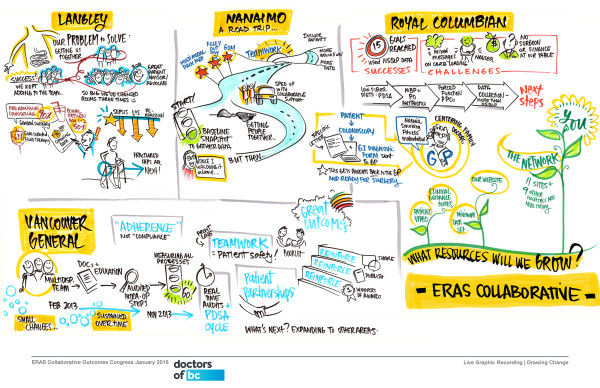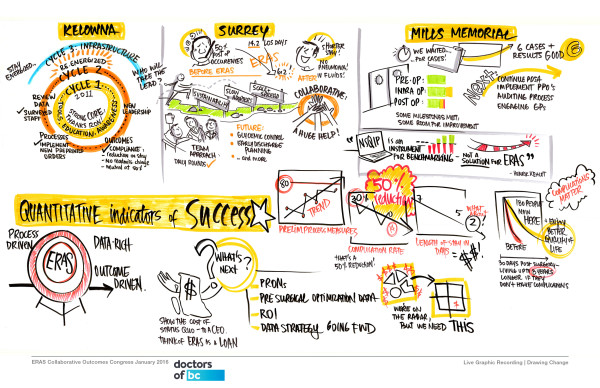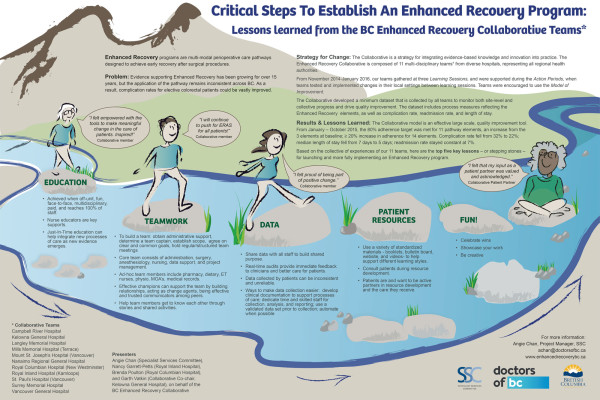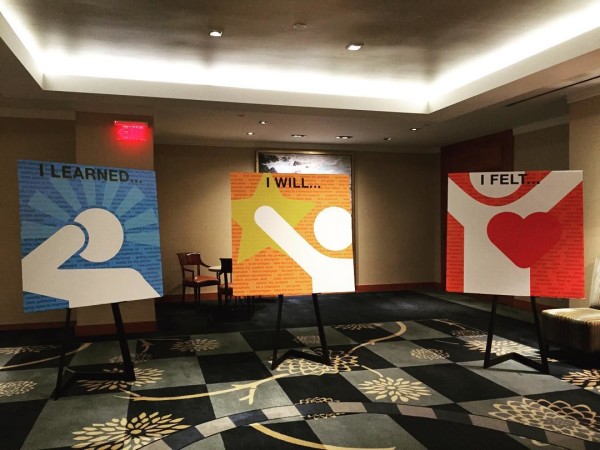3 ways to listen with confidence as a graphic recorder

If you’ve seen a graphic recorder in action, you might be curious how we listen and draw at the same time. And it’s a good question, because listening is more important than drawing in this job. At a recent event, I found myself listening with confidence in a new way — so I thought I’d share three listening tips I used. These graphic recordings aren’t the fanciest images – because I’m more excited to show you behind the scenes!
I was invited to scribe the Enhanced Recovery Collaborative Outcomes Congress in January. This day was the conclusion of a program run across British Columbia to improve surgery outcomes for patients. Each local group reported back on their challenges, successes, and where they were heading next.
THE CHALLENGE
Graphic recording for the healthcare sector— usually with researchers and clinicians — can often mean swimming in a sea of PowerPoint. Sessions can often be a full day of 15-minute presentations each with 20 – 40 slides. (If you’re curious, the all-time record I’ve seen is 70 slides.) For a graphic recorder, it’s a firehose of information.
Listening trick #1: Listening for the setup
In the health sector the takeaway is always the last slide. It’s possibly the academic influence, but I’ve learned this is part of the health-listening pattern. So while I’m recording I’m listening for the setup. Whenever possible, it’s great to get key information from speakers ahead of time – but we all know this isn’t always possible. And speakers, you can help the visual practitioner by telling them before you step on stage what is your main findings or key takeaway, even if you don’t reveal it to the audience until the end.
Listening trick #2: Listening for images
At this event, for the first 30 seconds to first minute of each talk I didn’t draw, instead I just listened for a metaphor or shape. I used this to structure a streamlined version of the content. These weren’t images found in the powerpoint at all, and this can be a breakthrough.
I heard various images; Sometimes it was descriptive, like “overlapping roles.” Sometimes it was jargon, or a common phrase like “roadmap to success.” Others were a challenge — I heard concentric rings, a path, a mountain.
Sometimes a speaker will choose a metaphor for their opening slide – but before you commit the beautiful picture to the page, listen to discover if the speaker will use this throughout the talk.

Listening trick #3: Listening for difference
I deliberately chose to not draw the ERAS collaborative program itself, as we had covered that in other visuals. This engagement was celebrating each local program’s success, so I was listening for what made them unique. This “Listening for difference” is an example of how graphic recorders can ask our clients for the purpose of our listening. Together, you and your client can identify themes to guide your listening. Is it themes of innovation? Communication? Or in this case, what is unique.
What helped: Building familiarity
I’d been working with this team for about 6 months, so I had absorbed the acronyms and program arc. I was familiar with the alphabet soup. Specifically, in a separate studio project (set of digital posters, a sample below), I had interviewed each individual team about their work so I also had a preview of what topics would come up. We created a customized, digital poster for each work site, and then made a summary poster to wrap up the major themes. Teams saw their work reflected in unique, custom images.

This digital poster from the interview series went on to win an award in the storyboard category at the Quality Forum held by the BC Patient Safety and Quality Council.
A final element that supported listening and reflection: we created an interactive area (often called a knowledge wall) to show that the organization “was listening”, too.

So the next time you are listening and drawing a session with a ‘firehose of information’, remember the different ways you can listen (with your ears and other senses, too!). Even under challenging conditions, as practitioners we can encourage ourselves to stay focussed and bring our best listening to each moment – for a better result for the images, and also the process.
One comment on “3 ways to listen with confidence as a graphic recorder”
This is sooo good! I needed to read this! Thank you for sharing! There is this element of trust – maybe FOMO with the pen that something being said will be missed so you fervently scribe it all and inevitably end up missing much… I guess listening isn’t just about scribing but about gathering, analyzing and then making the reflection of what was said count. So good! Thanks!